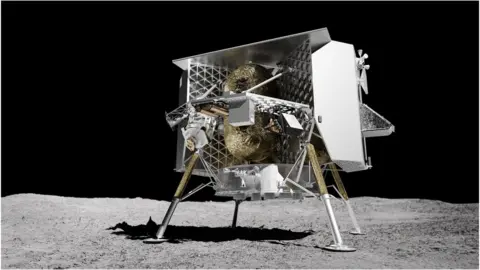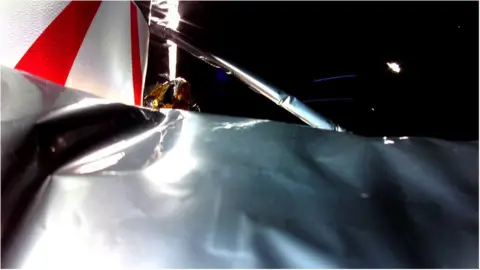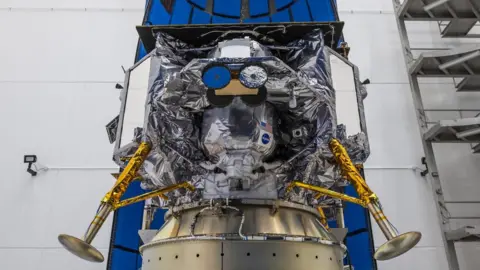Peregrine lander: Time running out for US Moon mission
 Astrobotic
AstroboticThe American company that launched a mission on Monday to try to soft-land on the Moon says it may not be able to control its spacecraft for much longer.
Pittsburgh-based Astrobotic is fighting a fuel leak from its Peregrine lander, which is making it hard to maintain stable pointing of the spacecraft.
Mission life could now be measured in just hours, the firm said.
Certainly, a touch-down on the lunar surface - the first for the US in half a century - is no longer possible.
"At this time the goal is to get Peregrine as close to lunar distance as we can before it loses the ability to maintain its Sun-pointing position and subsequently loses power," a statement from Astrobotic read.
The 1.2-tonne lander was launched from Cape Canaveral, Florida, with the intention of landing on the Moon's northern hemisphere in late February.
The US space agency (Nasa) had purchased capacity on the lander for five instruments to study the lunar surface environment ahead of sending astronauts there later this decade.
 Astrobotic
AstroboticPeregrine ran into trouble almost as soon as it came off the top of its launch rocket.
Engineers noticed the would-be Moon lander was struggling to keep its solar panels looking in the direction of the Sun to charge its battery.
The cause was quickly attributed to a major leak in the propulsion system that was pushing Peregrine out of alignment.
To maintain the correct orientation in flight, Peregrine's thrusters are now having to work overtime, consuming even more of the diminishing fuel supply.
Astrobotic calculates the craft has under two days' worth of propellant left before reserves are exhausted and the spacecraft starts tumbling.
When that moment arrives, Peregrine, with its solar panels no longer collecting sunlight, will rapidly lose power.
Astrobotic is the first of three US companies to send a lander to the Moon this year under a new private-public partnership with Nasa.
The agency is buying transport services from the Pittsburgh firm and two other commercial ventures - Intuitive Machines and Firefly. Together, the trio had planned six missions to the lunar surface in 2024. Astrobotic is supposed to be delivering a Nasa rover to Earth's natural satellite towards the end of the year.
All three US companies may have Nasa as their lead "customer", but the agency is not in charge of their projects. It is the firms themselves who have designed the spacecraft and are in command as the missions progress. And the companies are free to sell additional payload space to anyone who wishes to purchase it.
Peregrine, for example, is carrying some mini rovers for US and Mexican groups. It also has a consignment of human, and even dog, remains on board. Small capsules contain the ashes of tens of individuals, including Star Trek creator Gene Roddenberry and his wife, Majel, who was the voice of the computer on the USS Enterprise.
Nasa believes its new lunar partnership with the private sector will introduce more innovation and reduce costs over time. And the agency says it is prepared for some of these missions not to work.
Speaking to the BBC last month, deputy administrator Pam Melroy, said: "What we have learned from our commercial partners is if we have a high enough cadence, we can relax some of the requirements that make it so costly, and have a higher risk appetite. And if they fail, the next one is going to learn and succeed."
It will of course be frustrating for all those involved in the Peregrine project to see it fail.
Dr Simeon Barber from the UK's Open University led the development of the sensor in one Nasa instrument on the spacecraft. He told BBC News: "We started work on this particular project in 2019; it's been four years. The instrument was built through a pandemic; it was tough. This new way of doing space exploration does come with inherent risks. We know it's harder to do things right first time. So, the whole point of having a fleet of missions to the Moon in future years is to increase the chances of success."
 NASA
NASA